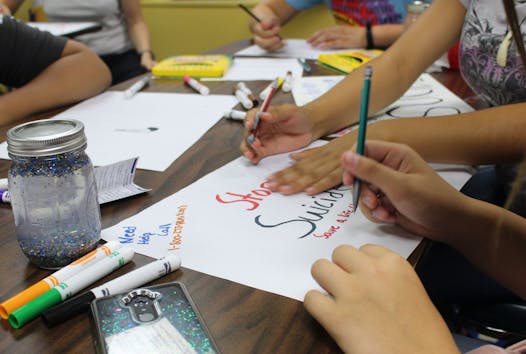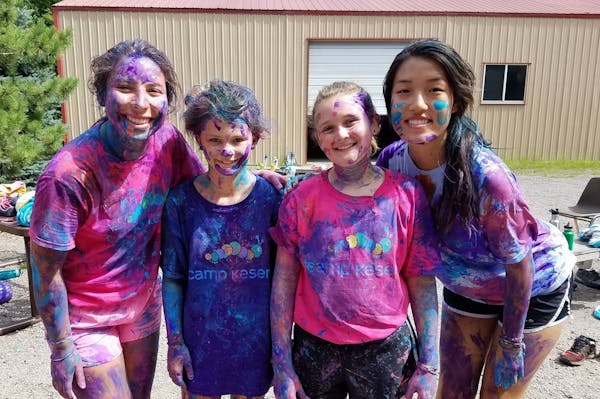A group of middle-schoolers shared colorful markers as they designed poster boards spread around two wooden tables scattered with glitter and informational packets. It was craft time for the teens, who were participating in an American Indian program called Keep the Fire Alive.
On her white poster board, Nalia Segura, 13, used a pencil to shade in long, dark hair on a mouthless face. Where the mouth should be, she wrote in bold red letters, "Suicide is not an option." To the right of those words, she drew a decorative dreamcatcher with a yin-yang center and three large feathers.
"Even people who have thoughts of suicide have dreams," said Segura.
Art, kids and suicide can seem like a perplexing, and troubling, mix. But members of the indigenous Peoples Task Force, who organize peer-based suicide prevention groups like Keep the Fire Alive, are helping to start an urgent conversation. Through meetings and training, Native youth are being schooled in warning signs of someone considering suicide, and why it's important to reach out to caring adults and other resources.
According to the 2015 Minnesota State Suicide Prevention Plan, Native youth ages 10 to 24 had the highest rate of suicide of any age group in Minnesota, 28 per 100,000 residents from 2010 to 2013. The rate was more than three times that of white youth (8.8 per 100,000).
Keep the Fire Alive held its first meeting in June at the All Nations Indian Church in Minneapolis, inviting all community members.
"It's a heavy topic, but I've seen that people want to help," said Brenna Depies, program director for Keep the Fire Alive, based in Minneapolis.
"The age group is good to work with, because it's a good time to talk about mental health," said Depies, noting that mental health issues can, and often do, begin to appear at this age; early prevention can lead to lasting changes and far less heartache.
Aside from educating and supporting Native youth to take care of themselves and feel confident to reach out when they need it, the program trains youth leaders to better identify warning signs in their peers.
Depies said it is important for young people to ask their peers how they are feeling, stressing that talking about suicide does not "plant a seed. A lot of times," she said, "teens are the only ones there for their peers."
Red Lake Middle School in Red Lake, Minn., also teaches that a direct approach is best. Last year, the school launched a chapter of the peer-led suicide prevention program, Hope Squad.
Students cover topics including self-care, safe and unsafe secrets, and ways to initiate a conversation about suicide. Students also learn how to directly start a conversation, with dialogue such as, "I'm worried about you," or, "Are you thinking about suicide?"
"A lot of what I see with my daily interaction with kids is they know what's going on," said Ayla Koob, a suicide prevention coordinator for Red Lake Comprehensive Health Services, who leads the school's Hope Squad chapter.
"They [play] this really pivotal role in helping each other out."
Hope Squad currently has 25 members, with two students placed in each of the school's 12 homerooms. Members are peer-nominated, cited as someone fellow students would most likely open up to about the subject.
"It's not teachers or staff electing who they think would be the best kids," said Koob. "It's truly the kids saying, 'This is who I would feel most comfortable with.' "
Keeping culture in mind
At a Keep the Fire Alive meeting in July, 13-year-old member Krissa Weitzel was busy decorating her sign with a list of protective factors, written in bubbly, rainbow lettering. Underneath the list, she added a supportive message: "There's Hope!" followed by a red heart.
She, like Segura, added the Suicide Prevention Hotline at the bottom: 1-800-273-TALK.
"If my family members are going through this stuff, I can tell them how to help it, like phone numbers and therapy," said Weitzel.
In addition to learning about resources, Weitzel said she learned that depression, lack of sleep, stress and childhood trauma can also be risk factors for suicide. Segura said she learned that a family history of suicide may bring an increased risk for survivors.
Keep the Fire Alive also addresses cultural factors, taking into account the intergenerational, historical and individual trauma affecting Indian youth communities, such as loss of land and language, and displacement. More than 20 percent of Native youth think daily about these sorrows, according to the Center for Native American Youth.
"Unfortunately, there's a lot of need for that prevention," said Verna Mikkelson, crisis program coordinator at White Earth Mental Health. The center provides counseling and mental health services for adults, children and family on the White Earth Reservation. "At the same time, if we don't talk about it, we don't know what the need is."
At White Earth Mental Health, safeTALK training is offered for teens ages 15 and up enrolled in local schools. Through three-hour trainings, participants learn about warning signs, community resources and TALK steps: Tell, Ask, Listen and Keep safe.
After Hope Squad meetings, Koob has the youths write down on a slip of paper if they need to talk. Hope Squad also helps kids identify their own coping skills, such as taking deep breaths or taking time to de-stress with a show on Netflix.
In addition to making poster boards, the Keep the Fire Alive group made calming jars to help re-center their thoughts, filling them with glitter, glue and water. Some jars were colored green and blue, some hot pink, some rainbow. Every now and then, someone would put down a marker to flip their jar, taking a couple of seconds to watch the glitter sparkle as it settled.
"I wanted to get out of my head," Weitzel said. "It's kind of fun because I've met new people. I look forward to coming every day."
Kids aren't counselors
In March, the Minnesota Department of Health received a $3.6 million federal grant to invest in youth suicide prevention programs in regions including Red Lake and Hennepin County. The Zero Suicide model aims to improve outcomes of those at risk for suicide, focusing on safety, prevention and connecting youth with services.
Peer programs can help reach that goal. With school back in session, Keep the Fire Alive is working to implement monthly meetings, serving as an advisory council to engage youth and build awareness in the community through events and outreach. White Earth Mental Health holds community safeTALK training sessions quarterly, and Hope Squad meets biweekly during the school year.
Some graduating eighth-graders are already thinking about continuing the group into high school, said Koob.
While peer-to-peer conversations are an important step in suicide prevention, Koob emphasized that the kids aren't counselors. Youth in suicide prevention programs also are taught the importance of seeking outside resources and next steps, such as counseling or calling lifelines.
"They are trained to be gatekeepers, to reach out, but then to always refer to an adult," said Koob.
But for the youth, peer prevention programs like Hope Squad and Keep the Fire Alive have helped foster a safe space to speak on subjects that are often silenced.
"It's OK to talk about what you're going through," said Segura. "There's someone out there who will actually listen."
John Adams' Nativity oratorio 'El Nino' gets colorful staging at the Met
Taylor Swift's 'The Tortured Poets Department' is here. Is it poetry? This is what experts say
Finding an apartment may be easier for California pet owners under new legislation
4/20 grew from humble roots to marijuana's high holiday




